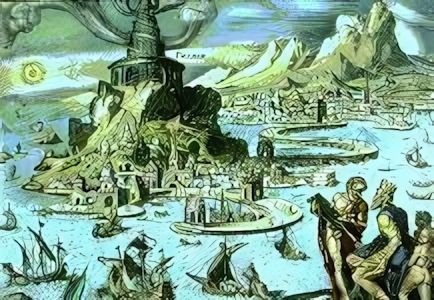Lighthouse collection - worldwide stamps, links and more!
This site brings together my lifelong passions — collecting stamps and more.
For a few years I collect the topical:
lighthouses on stamps.
To expand my collection I'm looking for other collectors
who want to exchange stamps. If you have something,
please let me know, maybe we can exchange some stamps.
As a guide I use the:
Seamark "Illustrated Catalogue of Lighthouse Stamps", compiled by Keith Hall.
|
A mist-shrouded lighthouse can shine a ray of beauty and calm on our imagination.
Even as waves batter their sides, lighthouses stand proud and erect,
guiding the way for all storm-tossed mariners. |
Some of the oldest lighthouses
The Colossus of Rhodes, was build around 280 B.C. It was about 30 meters high and was build to protect the harbor of Rhodes. The Greek and Romans considered it as one of the seven world wonders.

The pharos of Alexandria was on a island in the harbor of Alexandria and was more then 134 meters high.

What are Lighthouses:
A lighthouse is a structure, usually with a tower, built onshore or on the seabed to serve as an aid to
maritime coastal navigation. From the sea a lighthouse may be identified by the distinctive shape or color
of its structure, by the color or flash pattern of its light, or by the coded pattern of its radio signal.
History:
The first known lighthouse was the Pharos of Alexandria (see above), which stood some 350 feet (110 m) high.
During the first few centuries AD the Phoenicians and Romans also built lighthouses at numerous sites,
ranging from the Black Sea, along the Mediterranean and Atlantic coasts, to Britain.
After the fall of the Roman Empire in the 5th century, there was little maritime trade or travel, and no
lighthouses were built in Europe until the revival of commerce in the 12th century.
The French and Italians built the earliest of these lighthouses, followed by the Hanseatic League, which
constructed a number of such structures along the Scandinavian and German coasts.
The modern lighthouse dates from the early 18th century. Initially these towers were made of wood, but
wooden towers were often washed away in severe storms.
The first lighthouse made of interlocking masonry blocks was built on the treacherous Eddystone Rocks reef
in England in 1759. This structure, designed by the engineer John Smeaton, was also the first to employ the
classic curved hyperbolic design. Following the success of Smeaton's innovations, a large number of
lighthouses were built on the open sea.
Materials:
Interlocking masonry blocks remained the principal material of lighthouse construction until they were
replaced by concrete and steel in the 20th century. There are now three major kinds of offshore lighthouse
structures.
The first rests on a hollow, steel cylinder (caisson) that is partly sunk into the seabed and then filled
with concrete.
The second utilizes a concrete base that sinks to the bottom of the water, thus anchoring the lighthouse
tower that rises from this base.
The third, resembling an offshore oil rig, consists of a large deck supported by tubular steel piles driven
into the seabed; the tower rises from the deck.
Most lighthouses also have landing pads for helicopters.
Lights:
The standard illuminant of modern lighthouses (as well as lightships and buoys) is the electric lamp.
The most common type is the electric-filament lamp, which requires as much as 1.5 kilowatts to as little as
5 watts in small buoys. Refinements in lenses and reflectors have made it possible for a 250-watt bulb to be
boosted to several hundred thousand candlepower, or candelas.
The maximum intensity now sought in lighthouse beams is in the range of 100,000 candelas; this gives a beam
that can be seen from 20 nautical miles (37 km) in clear weather.
Sirens:
Sirens and horns are commonly used to provide audible warnings when a lighthouse and its beacon are obscured
by bad weather.
But because the range of their sound is also highly dependent on weather conditions, many lighthouses are
also fitted with radio and radar beacons, which either amplify a ship's radar or emit signals of their own
that can be detected by navigators.
The end of the lighthouse?
Radio and satellite-based navigation systems have greatly reduced the need for large lighthouses in sighting
land, although smaller structures are still important aids to navigating crowded coastal waters and shipping
lanes.
Almost all lighthouses are now completely automated, eliminating the expense of maintenance by resident
crews.
Modern computerized lighthouses analyze the weather, activate foghorns and other equipment, and transmit
signals to remote control stations ashore.
Some interesting lighouse related Links
We've photographed over 1,000 lighthouses in the USA and Canada. We have hundreds (more coming soon) of photos posted so you can see what lighthouses we've seen. We still have more to see in the coming years. We've written a travel book, "Lighthouses and Lightships of America--The Hunters Guide". We are The Lighthouse Hunters.
Anfang 1951 beauftragte die niederländische Lotsenfirma die Marinewerft Rijkswerf Willemsoord mit dem Bau von zwei Feuerschiffen nach Plänen aus dem Jahr 1948. Beide Schiffe, Nummer 10 und Nummer 11, wurden am 11. August 1951 zu Wasser gelassen. Das Feuerschiff Texel Nr. 10 hat einen Tiefgang von 2,92 Metern und ein Gesamtgewicht von etwa 500 Tonnen. Die Länge beträgt 45,5 Meter und die Breite 7,92 Meter. Ursprünglich war das Schiff mit drei Pilzankern von je 750 kg Gewicht ausgestattet.
The Lighthouse network of Greece has 120 Traditional lighthouses today, which are approximately two centuries old.